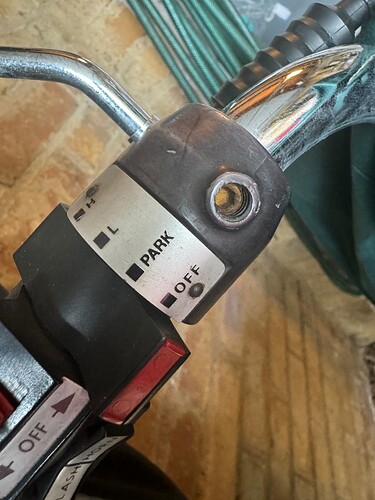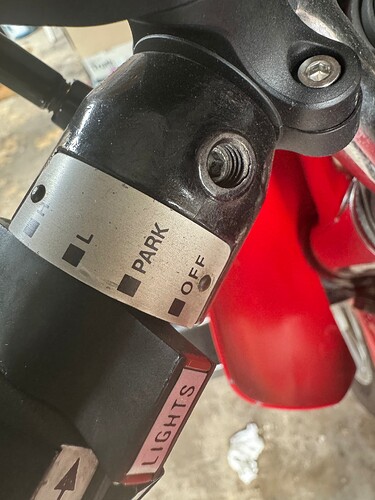Does anyone know how much fork oil to use on the Mk 1 Le Mans and what weight oil to use? Thank you
I got 60cc each leg for Le Mans (1 & 2), and automatic transmission fluid (‘ATF’).
Assuming your forks are factory stock, they will have sealed dampers so the oil is not used for damping, only lubrication. You must remove the top caps in order to drain properly, just removing the drain plugs does nothing (guess how I know). If both top caps are off the sump will have to be supported to prevent the bike falling forward (we’re assuming it’s on its mainstand), because the fork springs can’t hold it up. ![]() Hope that makes sense.
Hope that makes sense.
That’s really helpful. Thanks so much. Do you have any guidance re the weight of the oil? Mick Walker’s Restoration book seems to suggest 7.5 oil.
Thanks again
Rupert
As it is for lubrication only it isn’t critical. I use 7.5W Synthetic Fork Oil, but ATF will do (around 5W).
See
Thank you!
Hello there,
my books tell me Mk1 should have 120 cc ATF per leg, and Mk2 should have 60cc ATF per leg. I Put normal 10W fork oil in mine just to lubricate the stanchions in the sliders. I figured motorcycle fork oil is likely to have the right additives to lube that interface.
Thanks Andy for taking the trouble to respond. What book tells you 120ml/cc? That’s quite a difference to the previous advice. My 1976 T3 original manual says 70cc/ml. Regards, Rupert
I have official factory workshop manuals for them.
The first manual is for V7 Sport, 750S, 850 T and 850 T3. Part number 1492 0120.
It has supplement for the 850 Le Mans ( 1976-1978 ), as it was officially known then. That has part number 1492 0151, and is subtitled ‘additions and changes to the workshop manual for V7 Sport - 750 S - 850 T Cod 1492 0120’.
I can’t see any dates in the copyright bit, or anything like that.
The main manual says all those first models should have 50cc Agip F1 ATF Dexron in each leg. The Le Mans supplement overrides that by saying 120 cc each leg Agip F1 ATF Dexron. It also has the same quantity referenced in the fuel and oil capacities chart inside the front cover, so it’s not a misprint.
The next book is the official factory workshop manual for the V1000G5, 1000SP, 850 Le Mans II and 850 T3. Subtitled ‘additions and changes for 850 T3 model’. No part number or year reference, but given it 's the MkII Le Mans it must be '78 or '79. There it specifies 80cc per leg for V1000 G5 and 90 cc per leg for 1000SP, both Agip F1 ATF Dexron. The supplement later in the book for the LM2 says 90 cc per leg Agip F1 ATF Dexron. And I see my earlier post had a mispront. It’s 90 cc for the LM2, not 60; sorry about that. There’s another supplement for the T3 later in the book. That says 60 cc per leg, Agip F1 ATF Dexron, again both in the summary table of quantities at the beginning, and in the chapter for fork maintenance.
So, what I find interesting is looking at the T3, your '76 manual ( owner’s or workshop ? ) says 75cc, the next update in '78 says 50cc, and the subsequent update around '79 says 60cc. BTW, that’s why I got the MkII value wrong; it’s easy to flip through the pages and get the wrong supplement.
But my official workshop manuals say 120cc per leg for Mk1 and 90 cc per leg for MkII.
I should add here, that a difference in the amount of oil you put in is only going to affect the amount of air assist you have in the suspension, because the damping is completely taken care of by the cartridges. The more oil you put in, the less the volume of air and thus the greater the amount of air compression for a given amount of fork compression, so more air assist. Up 'til the point at which it hydraulic locks ( more or less ) if you put too much in. Given I don’t think I’ve bottomed out the forks with 120cc in, that shouldn’t be an overfill.
Thank you again Andy. That’s an incredibly (and very helpfully) detailed answer. I’ll go with 120cc weight 7.5 then given mine is a Mk 1 (1977). My T3 manual is the little red owner’s manual supplied with the bike (fitted under the seat) but I will double check again before changing the oil in those forks too.
Really grateful for your wonderful response. Regards, Rupert
Thanks for that - my info came from factory workshop manual G5 & SP 1000, LM2 supplement - the 60 cc is a misprint in the book then! ![]() I thought it seemed a bit small. 90 cc makes more sense.
I thought it seemed a bit small. 90 cc makes more sense.
I had a LM1 so must have done this, actually I had a speciall tool made (basically, a long bolt whose head fitted the hex hole and a 90° bend put in it) to remove the top caps, bu couldn’t tell you now how much ATF I put in.
What I do know is there was a big bottle of ATF in the shed that only came out once a year or so! ![]()
Thanks Andy for this. I suspect the oil in the forks of mine have only been changed once in 50 years. So it’s going to be interesting to see how an oil change affects them. Am I likely to need a special tool to undertake the oil change? (I have someone experienced in bikes helping me do this). Regards
Rupert
I really don’t think you’ll need special tools. I think Mike is talking about making up an Allen key to fit the top caps. It’s quite a big one ( I can’t remember the size off the top of my head ) so most sets don’t go up that big. The only gotcha I can think of is the drain plugs are originally slot head screws ( I think ), so may be a bit tricky. I’d replace the aluminium sealing washer underneath it. Guzzi forks are very different from anything of that era, so your friend’s previous motorbike experience may not help them.
However, if you think they’ve not been apart in that long, the damper units are almost certainly useless by now. The originals weren’t very good to start with and didn’t last long anyway. Changing the oil isn’t going to improve the ride. Can you tell if there’s any damping in the front suspension ?
It is, I did since buy an Allen socket bit, still can’t tell you what size, something like 21mm? Anyway you can get them on eBay etc.
Thank you both - including for clarifying about the special tool. I’m fairly confident my friend will have a sufficiently big Allen socket bit.
I’ve ordered new FAC damper units from Gutsibits (part SUA14408) and a progressive spring set (part SUA14601) so we are hoping to be able to fit those. Have ordered dust seals and seals too. Also fully adjustable rear shock absorbers with chrome springs. With the oil I’m hoping that will work well.
Good idea about replacing the aluminium sealing washer. I’ll speak to Gutsibits about that tomorrow.
Thank you again both.
Meantime, I’m going to start another thread asking to see if anyone knows what these threaded holes on the left handle handlebar are (photos taken from the Le Mans Mk1 and the 1976 t3). Do either of you have any idea? Gutsibits didn’t.
Looks like grub screws to keep the switches in position ![]()
Yes, that’s exactly what they are. It looks like they both have grub screws fitted. To remove the switch assemblies you need to slacken the Allen headed grub screws. That top one, looks like T3, seems a little rusty. I’d treat them both to a few drops of PlusGas now, whether they need to move in the near future or not.
FAC dampers and the Wirth springs are a great move. You’ll not be disappointed.
The switch gear was not very good when new, but if you can persist with them for the sake of originality then try hard to as replacements are like hens teeth and go for silly money if you can find them.
I have kept my original switches apart from the light switch, as I no longer have indicators I have repurposed the indicator switch for the lights.
As said above the grub screws hold the switches to the handlebars.
Thank you both! That answers that. I was 18 when my dad bought the T3 and I very, very vaguely recall there being a rubber stopper covering the threads. Am I imagining that I wonder??
Separately, I updated my Gutsibits order today to add the fork washers (thanks again for mentioning that) and ATF oil. Funnily enough Gutsibits said 60ml is needed in each leg, but I said I’d got chapter and verse from good sources. Going to be interesting to see how much comes out!
Thanks again for all your help.
Regards, Rupert
Sounds like you’re well on the way. As regards how much oil to use, bear in mind that all we’ve done is relay the best information from the factory literature. It’s entirely possible that people have found 60/90 ml gives a more comfortable ride. Gutsibits are more likely to hear about that than we are. I’d love to hear. I’ve experimented with different oil/air volumes in other machines but not the Le Mans. Actually, now I think about it, the first time I did the forks the only literature I had at the time would have been the Mk2 manual, so it would have had 90ml for all those years. I put 120ml in a few years ago when I did the FAC/Wirth build you’re now doing. I can’t judge the results because my old dampers were shot ( again ) and the old springs had taken a set and were Mk2 springs so didn’t work well inside the Mk1 stanchions.
I’ve never seen a rubber stopper, but then it’s exactly the sort of thing that would fall out within the first year. And the Guzzi parts book has no listing for any sub-parts for that lever assembly, except the lever blade itself. I believe the Tommaselli part number for that assembly is Tommaselli 0343.04 Perhaps somewhere on the InterWebz there’s a breakdown, or maybe there’s a rubber stopper available as a Tommaselli part.
Chris has really good point about the switchgear. The plastic is really quite fragile, so as tricky as it is to use, it’s best to be as gentle as possible. The copper light switch contacts also burn really badly. I’ve had to solder tiny pads of brass shim onto the pitted remains of the copper pads twice now and finally gave up about 15 years ago and replaced it with a more modern cluster that actually works. I’ve kept the original stuff sealed in a poly bag and have repaired it again in case I lose my mind and decide to put it back on.
The solution here would be to actually put relays into the headlight circuit to reduce the current through the switch, but there we go.
Good luck.

